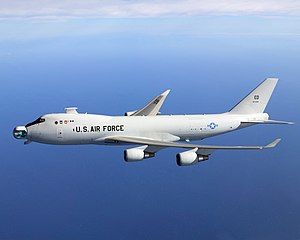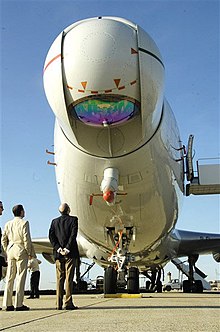Boeing YAL-1
| Boeing YAL-1 Airborne Laser | |
|---|---|
 Test flight of the YAL-1 prototype |
|
| Type: | Prototype of a laser-based missile defense aircraft |
| Design country: | |
| Manufacturer: | |
| First flight: |
July 18, 2002 |
| Commissioning: |
In flight testing |
| Production time: |
Not mass-produced |
| Number of pieces: |
1 (00-0001 / ED ) |
The Boeing YAL-1 Airborne Laser was a flying laser - energy weapon system for defense against approaching enemy missiles that was tested by the US Air Force between 2001 and 2012. A modified Boeing 747-400F served as the basis, inside which a high-energy laser beam was generated and fired through the bow at the target.
Development history
The US Air Force (USAF) has been working on concepts for an airborne laser weapon since the early 1970s . As part of the Airborne Laser Laboratory (ALL) program, she installed a laser on board a converted KC-135A Stratotanker tanker to test missile launching. This succeeded until the mid-1980s, albeit with air-to-air missiles that were destroyed or at least deflected from close range. This model became known as the NKC-135A Laser Lab .
In the following years, the planned use shifted to the detection of enemy ballistic missiles during their launch phase and their destruction by bombardment with laser pulses lasting a few seconds in the megawatt range from several hundred kilometers away. The aim of the irradiation is to heat up the rocket's casing and thus force the construction to fail or fail. In 1994 the US defense budget provided funds for the first time to develop such a system, and the USAF has been working specifically on the implementation of the project, now called Airborne Laser (ABL) , since 1998 .
The US Air Force procured a new Boeing 747-400F in January 2000 and began the conversion. The first flight of the prototype YAL-1A took place (still without laser) on July 18, 2002 at Boeing in Wichita , Kansas , since the end of 2002 further tests and the installation of the laser technology have been on the program at Edwards Air Force Base . An existing six modules serves as the main laser chemical oxygen-iodine laser (Chemical Oxygen Iodine Laser, short COIL) , the invisible radiation in the infrared range emitting (1315 nm). It was first put into operation on November 10, 2004. In addition to the laser cannon, three auxiliary lasers are to be used for target acquisition, marking and for measuring atmospheric disturbances. The laser system does not burn through the missile or destroy it directly, instead it heats the outer shell of the missile strongly and thereby weakens it. The aerodynamic forces acting on the then soft material should then lead to failure of the rocket.
The rollout of the YAL-1 took place on October 27, 2006 in Wichita. On March 15, 2007, it fired a laser in flight for the first time: The target marking laser detected a C-135 (NKC-135A) specially equipped for this mission , which carried a painted rocket on the front fuselage for these tests. A first practical test of the main laser in flight was originally planned for 2003, but has been postponed several times. On August 10, 2009, the Boeing 747-400F fired for the first time with low energy at a real approaching rocket, which was launched around 120 km away. The first high-energy shot was fired off the coast of California on February 11, 2010 . Initially, the purchase of seven machines was planned. In July 2009, however, US Secretary of Defense Robert Gates announced that the defense budget would be massively cut and that various projects would not be pursued, including the Airborne Laser .
For cost reasons, the program was finally ended in early 2012 and the USAF decided to mothball the Boeing 747 it was using, with the option of reactivating it at a later date. The use as a research carrier, as initially decided, will therefore not be realized. If the practical tests had been successful and the AL-1 had actually been put into service, it would have been the first directed energy weapon of the US armed forces . In mid-February 2012, the AL-1 made its last flight to the Aerospace Maintenance and Regeneration Center in Tucson , Arizona .
In addition to Boeing as consortium leader, Northrop Grumman for the laser system and Lockheed Martin for the fire control system were also involved in the project.
Importance of the project
The airborne laser was an important element of the US national defense strategy against enemy rocket attacks ( National Missile Defense ). At the end of 2001, the Missile Defense Agency of the Department of Defense took over the management of the project.
The fact that the Airborne Laser was not an ordinary project for the USAF was shown by the license plate number of the prototype (00-0001) and above all by the designation AL-1 , which - as with the SR-71 and the F-117 - does not Corresponding to our own guidelines for naming aircraft : The main identifier L (for laser ) has only been reserved since 1997, a point in time after the start of the program. This was the first time that a USAF aircraft was named according to the type of equipment and not, as usual, according to its purpose (e.g. B for bombers ). The second identifier, which stands for a special or additional purpose, is also incorrect, since the A is intended for attacks, but the F is intended for fighting missiles . Perhaps you may have for AL chosen because it is considered acronym for Airborne Laser is.
Technical specifications
| Parameter | Data |
|---|---|
| Type: | Prototype of a laser-based missile defense aircraft |
| Length: | 70.70 m |
| Span: | 64.44 m |
| Wing area: | 541.16 m² |
| Wing extension : | 7.67 |
| Wing loading : |
|
| Height: | 19.41 m |
| Empty weight: | 181,120 kg |
| Maximum take-off weight: | 396,900 kg |
| Top speed: | Mach 0.83 |
| Maximum altitude: | 13,700 m |
| Maximum range: | 15,570 km |
| Drive: | Four General Electric CF6 -80C2- turbofan engines with a thrust of 280.97 kN each |
| Crew: | Six (pilot, co-pilot, four operators) |
Quotes
“Speed-of-light / line-of-sight weapons like the laser on the ABL are fundamentally different from kinetic weapons. Line-of-sight precision ensures one-shot, one-kill effectiveness. Speed-of-light response ensures that the target has no warning to make evasive maneuvers or employ countermeasures. If the technology proves practical and affordable, a DE weapon will provide a near-instant kill of targets detected within its effective range. Echoes of Giulio Douhet's combat plane able to clear its way through the skies with superior firepower can be heard as the ABL takes flight. "
“Weapons with a fast, direct shot like airborne lasers are fundamentally different from kinetic weapons. The precision of the sight line ensures destruction with the first shot. The lightning-fast reaction ensures that the target does not receive any warning for evasive maneuvers or for taking countermeasures. If the technique proves to be practical, a weapon with directed energy will enable targets detected in its effective range to be eliminated almost instantaneously. You can hear the echo of Giulio Douhet's fighter plane, which makes its way through the sky with superior firepower as soon as the ABL takes off. "
See also
Web links
- Link overview to the Airborne Laser from Globalsecurity.org
- AirForce Directed Energy Directorate ( Memento of April 29, 2007 in the Internet Archive )
- Boeing Missile Defense: Airborne Laser System
Individual evidence
- ↑ a b c Lights Out for ALTB . In: Air International . Key Publishing, February 2012, ISSN 0306-5634 , p. 14 (English).
- ↑ Eric M. Grill: Airborne Laser fires tracking laser, hits target. USAF News, March 21, 2007.
- ↑ Luis David Sanchez: 55-3132 (cn 17248). Image of the NKC-135A on Airliners.net. July 2007, accessed February 21, 2012 .
- ↑ Jonathan E. Skillings: Airborne Laser zaps in-flight missile. In: CNet News. February 12, 2010, accessed on February 21, 2012 (English): “In a milestone for the ambitious directed-energy project, now dramatically downsized, the Pentagon's Airborne Laser prototype weapons system destroyed a ballistic missile that was in flight. The shootdown took place February 11 off the central coast of California. "
- ^ Robert Gates : Speech. Speech by the then US Secretary of Defense to the Economic Club of Chicago. US Department of Defense, July 16, 2009, accessed February 12, 2012 : “Consider the example of one of those programs - the Airborne Laser. This was supposed to put high-powered lasers on a fleet of 747s. After more than a decade of research and development, we have yet to achieve a laser with enough power to knock down a missile in boost phase more than 50 miles from the launch pad - thus requiring these huge planes to loiter deep in enemy air space to have a feasible chance at a direct hit. Moreover, the 10 to 20 aircraft needed would cost about $ 1.5 billion each plus tens of millions of dollars each year for maintenance and operating costs. The program and operating concept were fatally flawed and it was time to face reality. So we curtailed the existing program while keeping the prototype aircraft for research and development. "
- ↑ Gates wants to reallocate military spending. In: Frankfurter Rundschau. April 6, 2009, accessed on February 21, 2012 : "In addition, a futuristic component of ballistic missile defense was expected to be dispensed with, including an airborne laser and a space-based interception system."
- ↑ Christopher Drew: Soaring Costs Jeopardize Missile Defense Systems. In: New York Times. March 17, 2009, accessed on February 21, 2012 (English): “Mr. McAleese said it seemed clear that programs still being tested, like the laser, which would be mounted on a Boeing 747 plane, and the mobile system, known as the Kinetic Energy Interceptors, would be among the most vulnerable. "
- ^ Dante D'Orazio: Laser-equipped 747 missile-buster flies last flight, claims its spot in the Boneyard. The Verge.com, February 21, 2012, accessed on February 21, 2012 (English, article about the last flight of the AL-1 with video): “Funding for the laser-equipped 747 known as the Airborne Laser Testbed was cut late last year , and the aircraft has been reassigned to the 309th Aerospace Maintenance and Regeneration Group - fondly called the Boneyard - where decommissioned aircraft go to die. "
- ↑ US Outlines Plans for $ 487 Billion Defense Budget Cuts . In: Air Forces Monthly . Key Publishing, March 2012, ISSN 0955-7091 , p. 20 (English).
- ↑ John D. Jogerst, Colonel (retired) USAF: Airpower Trends 2010 - The Future Is Closer Than You Think. Airpower.au.af.mil, June 1, 2009, accessed February 21, 2012 .


